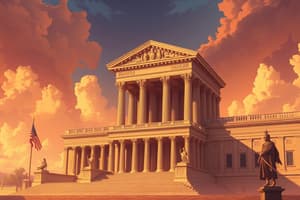Podcast
Questions and Answers
Which of the following is a Constitutional Court?
Which of the following is a Constitutional Court?
- Court of International Trade (correct)
- A state Supreme Court
- Supreme Court (correct)
- District Court (correct)
What was a major challenge encountered in the US during the Confederation era (1781-1789) in regards to law enforcement?
What was a major challenge encountered in the US during the Confederation era (1781-1789) in regards to law enforcement?
- The absence of a federal judiciary led to inconsistent interpretation of laws (correct)
- A lack of a national currency made it difficult to collect taxes to enforce laws
- State governments failed to establish local law enforcement agencies
- Lack of a national army made it difficult to enforce laws against individuals
Which of the following statements accurately reflects the relationship between Congress and the federal court system?
Which of the following statements accurately reflects the relationship between Congress and the federal court system?
- Congress has no power to create lower federal courts, only the Supreme Court is established by the Constitution.
- Congress establishes the Supreme Court, while state legislatures establish lower federal courts.
- Congress and the Supreme Court share equal power in establishing the federal court system.
- Congress has the authority to create lower courts, and the Supreme Court is the only court established by the Constitution. (correct)
Why did Alexander Hamilton advocate for a national judiciary system in his Federalist essays?
Why did Alexander Hamilton advocate for a national judiciary system in his Federalist essays?
What does the phrase "inferior courts" refer to in the context of the US judicial system?
What does the phrase "inferior courts" refer to in the context of the US judicial system?
Flashcards
Dual Court System
Dual Court System
The US has two court systems: federal and state.
Constitutional Courts
Constitutional Courts
Courts established by the Constitution to exercise judicial power.
Special Courts
Special Courts
Courts created by Congress with limited jurisdiction.
Federal Judiciary Creation
Federal Judiciary Creation
Signup and view all the flashcards
Judicial Power
Judicial Power
Signup and view all the flashcards
Study Notes
Dual Court System
- The US has two separate court systems: federal and state.
- Federal courts handle cases across the country, with over 100 courts.
- State courts are present in each of the 50 states, with thousands of courts.
- Most cases are heard in state courts, not federal.
Types of Federal Courts
- Constitutional Courts: Created by the Constitution, including the Supreme Court and lower federal courts (courts of appeals, district courts, and the U.S. Court of International Trade).
- These exercise the "judicial Power of the United States."
- Special Courts: Created by Congress, these handle specific issues.
Creation of the National Judiciary
- During the Articles of Confederation (1781-1789), there were no national courts.
- The lack of a national judiciary was a significant weakness.
- States sometimes interpreted and applied laws differently.
- Disputes between individuals and states were often settled by state courts, and decisions were not consistently respected.
- Alexander Hamilton argued for a stronger judiciary in The Federalist No. 22, highlighting the need for courts to define laws.
- The Constitution established a national judiciary with a Supreme Court and allowed Congress to create lower courts.
- The "judicial Power of the United States" is vested in one Supreme Court and other inferior courts.
Judicial Power of the United States
- Congress has the power to create lower federal courts.
- This is outlined in Article III, Section 1, and in Article I, Section 8, Clause 9 of the Constitution..
Studying That Suits You
Use AI to generate personalized quizzes and flashcards to suit your learning preferences.



